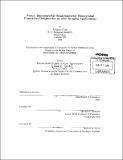Smart, biocompatible semi-conductor nanocrystal constructs designed for in-vitro imaging applications
Author(s)
Lee, Jungmin, Ph. D. Massachusetts Institute of Technology
DownloadFull printable version (15.15Mb)
Other Contributors
Massachusetts Institute of Technology. Department of Chemistry.
Advisor
Moungi G. Bawendi.
Terms of use
Metadata
Show full item recordAbstract
Quantum dots (QDs) have unique optical properties that complement fluorescent proteins and organic fluorophores. Despite the widespread use as a fluorescent label in biological imaging studies, the types of biological questions answered by utilizing QDs have been limited due to crucial shortcomings. This thesis focuses on pushing the boundaries of QD applications in vitro, exploring improvements in construct design and methodology to overcome these shortcomings. First, the issues of non-specific binding and reactivity are alleviated by exploring a new method to conjugate molecules onto the QD surface. The improvements that were made enabled a collaborator situated across the country to conjugate biomolecules in a one-step process without performing the usual amine/N-hydroxysuccinimide coupling, thereby diminishing non-specific binding. The utility of QDs in biological applications is further demonstrated by incorporating the nanocrystals into a dynamic sensor construct and taking measurements in a bioenvironment. A dye construct that can act as a Fluorescent Resonant Energy Transfer (FRET) acceptor is conjugated to the FRET donor QD through a molecular linker whose conformation changes depending on the analyte in the microenvironment. As a proof-of-concept, pH is chosen as the environmental factor and the QD-dye FRET sensor is used to track the pH in subcellular compartments along the endocytosis pathway. Lastly, a new microfluidic device is used to deliver QDs into the cell cytosol with high viability and high throughput. QDs delivered this way are shown to be nonaggregated and to interact with the cytosolic environment, opening up the possibility of single molecule tracking of a specific protein of interest inside the cytosol.
Description
Thesis (Ph. D.)--Massachusetts Institute of Technology, Dept. of Chemistry, 2013. Cataloged from PDF version of thesis. Includes bibliographical references.
Date issued
2013Department
Massachusetts Institute of Technology. Department of ChemistryPublisher
Massachusetts Institute of Technology
Keywords
Chemistry.